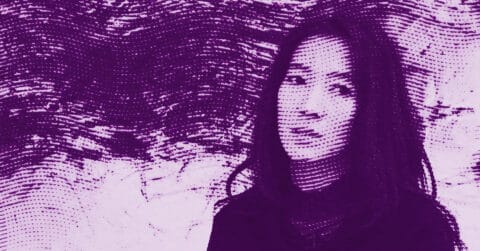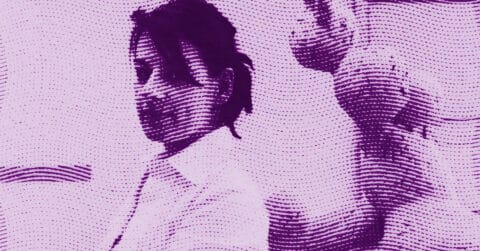Listen to me carefully, you bunch of snobs, it is high time to talk about Laura Owens, this artist who joyfully upends your smug certainties about contemporary art. From her Los Angeles studio, she orchestrates a silent revolution that shatters all your comfortable little boxes.
Did you think painting was dead? That after abstraction, minimalism, and conceptual art, only recycling old recipes remained? Let me tell you how this Ohio native, with her cutting humor and sharp intelligence, reinvents the pictorial medium with every new brushstroke.
Owens stands out by her stubborn refusal of dogmas. She gleefully pillages art history, borrows from popular cultures, digests technological innovations, and transforms it all into works that defy any categorization. But beware, do not be fooled by the apparent lightness of her work. Beneath the sour colors and playful patterns lies a profound reflection on the very nature of art and our relationship to images.
Let us take time to explore the concept of “simulacrum” developed by Jean Baudrillard, as it brilliantly enlightens Owens’s work. For the French philosopher, our era is characterized by the proliferation of images that refer only to other images, creating a vertigo of representation where the very notion of original loses its meaning. Owens’s paintings fully embrace this postmodern condition, but with an unexpected twist: they make it a jubilant playground.
Look at her recent works, where she incorporates printing plates of newspapers from the 1940s discovered during the renovation of her studio. These fragments of history are digitized, manipulated in Photoshop, reprinted in screen printing, then reworked by hand. The original and the copy, the manual and the mechanical, the historical and the contemporary intertwine until they become indistinguishable. This is precisely what Baudrillard described as hyperreality, but Owens transforms this potentially anxiety-inducing condition into a source of wonder.
This approach is manifested in a particularly spectacular way in her monumental installations, such as the one presented at the Whitney Museum in 2017. The paintings unfolded like a visual labyrinth where each viewer traced their own interpretative path. Deceptive cast shadows, contradictory perspective effects, overlapping patterns created an experience that challenged our usual ways of reading the image.
A second philosophical concept resonates powerfully in Owens’s work: it is that of the “death of the author” theorized by Roland Barthes. According to the French literary critic, the meaning of a work does not lie in the intentions of its creator but in its interpretation by the viewer. Owens pushes this idea to its most extreme limits. Her canvases become spaces of freedom where references accumulate without hierarchy: a touch reminiscent of Matisse stands next to a cheap wallpaper pattern, an abstract expressionist gesture dialogues with a children’s book illustration.
This radical democratization of visual references is not the result of chance or easy relativism. It is an aesthetic and political stance that challenges traditional hierarchies of art. Owens refuses the posture of the demiurge artist who would impose her vision on the viewer. Rather, she creates works that function as complex mirrors, reflecting a different image to each person depending on their angle of approach.
Take, for example, her 2012-2013 series, where oversized brush strokes float like ribbons in space, their cast shadows creating an illusion of depth while emphasizing their artificiality. Vichy checkered patterns, emblems of domestic kitsch, serve as the background to these grand pictorial gestures. It’s as if she is saying to us: “Yes, all of this is artificial, so what? Isn’t it magnificent?”
This pure joy in the act of painting is contagious. Owens does not hesitate to use electric colors, assumed decorative patterns, spectacular visual effects. She refuses the posture of the tortured artist, preferring that of the conjurer who reveals her tricks while continuing to amaze us. This attitude is not naivety, but a sophisticated form of sincerity.
The artist goes even further in this reflection in her approach to exhibition space. At 356 Mission, the space she managed in Los Angeles from 2013 to 2019, she created environments that radically transformed our experience of painting. The works were no longer isolated objects to contemplate, but elements of a total experience where architecture, light, and even the visitors’ movement participated in the aesthetic experience. Her use of space is remarkable. In her installations, the paintings are not simply hung on the wall; they activate the surrounding space. Cast shadows create virtual extensions of the works, patterns seem to extend beyond the frame’s limits, perspective effects transform our perception of the architecture. The exhibition becomes a complex choreography where the viewer is invited to actively participate.
This participatory dimension is fundamental in her work. Owens’s paintings are not authoritarian statements about what art should be. They are invitations to play, explore, and question our certainties. She creates works that function as awakening devices, pushing us to look beyond appearances.
Her trompe-l’oeil technique is particularly revealing in this regard. The cast shadows in her works do not simply serve to create an illusion of depth, but become autonomous elements that play with our perception of space. These shadows are sometimes painted with photographic precision, sometimes stylized like in a comic strip, creating a constant tension between different levels of representation.
This playful approach to representation resonates particularly in her way of treating natural motifs. Her paintings of flowers and animals do not seek botanical or zoological realism. On the contrary, they embrace a form of fantasy reminiscent of children’s book illustrations or medieval tapestries. But once again, this apparent naivety hides a sophisticated reflection on the nature of representation.
In her recent works, Owens explores new dimensions of pictorial experience. She integrates sound elements, mechanical devices, and light effects that transform her paintings into true immersive environments. These technological innovations are not gadgets, but natural extensions of her research on the possibilities of painting in the digital age.
Her engagement with technology is particularly interesting. Unlike many contemporary artists who oppose digital to manual, she sees these two domains as complementary. Her paintings incorporate digital printing techniques, Photoshop effects, computer-generated patterns, but these elements are always in dialogue with traditional pictorial gestures. Digital becomes a tool among others in her artist’s toolkit, on the same level as oil painting or screen printing.
This hybridization of techniques reflects a broader vision of art as a space of infinite possibilities. For Owens, there is no hierarchy between different means of expression. A gestural paint stain can coexist with a mechanically printed pattern, a reference to art history can dialogue with an emoji. This democratization of references and techniques is not facile relativism, but a deep aesthetic and ethical position. This approach demonstrates a profound understanding of our era, where digital is no longer a novelty but a constituent element of our daily experience. Owens’s paintings reflect this reality without nostalgia or excessive technophilia. They show how painting can absorb and transform technological innovations while retaining its specificity.
Humor plays a central role in this endeavor of breaking down barriers. Owens’s paintings are often funny, not in a cynical or ironic way, but with an authentic joy in the absurd and the unexpected. This humorous dimension is not superficial: it is an integral part of her strategy to unsettle our expectations and open us up to new ways of seeing.
Let’s take her series of paintings based on grids and geometric patterns. At first glance, they seem to fit within the modernist tradition of geometric abstraction. But upon closer inspection, one discovers breaks, distortions, figurative elements that disrupt this reading. The grids turn into school notebook paper, the geometric shapes become windows or screens, and the flat areas of color reveal digital textures.
This strategy of constantly disrupting the viewer’s expectations is not gratuitous. It reflects a deep conviction: art should not comfort us in our certainties but rather push us to question our habitual ways of perceiving. Each painting by Owens is an invitation to slow down, to observe attentively, to discover the multiple layers of meaning and references hidden within.
Laura Owens’s work reminds us that painting is not an exhausted medium but a constantly expanding territory. She shows us that it is possible to be both deeply serious in one’s artistic practice and joyfully irreverent in approach. Her paintings are invitations to rethink not only what art can be today but also how we can experience and talk about it. In an art world often dominated by cynicism and theory, Owens offers a refreshing alternative: a practice that embraces complexity while celebrating the pure pleasure of creation. Her works remind us that art can be both intellectually stimulating and viscerally satisfying, conceptually rigorous and visually enchanting.
Yes, listen to me carefully, you bunch of snobs, Laura Owens upends your well-ordered categories and comfortable theories. And that is exactly what contemporary art needs: less posturing and more possibilities, fewer dogmas and more discoveries. In her Los Angeles studio, she continues to push the boundaries of what a painting can be, inviting us all to follow her in this joyful and rigorous exploration of the infinite possibilities of art.
















